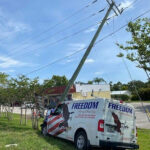As first published in sister publication Vero Beach 32963 on Dec. 16
VERO BEACH – Just when Vero Electric ratepayers were getting used to the fact that the voters elected a new City Council bound and determined to sell the system to Florida Power & Light, Mayor Jay Kramer is planning to reveal his ‘Plan B.’
Kramer, it turns out, is not convinced that Vero needs to sell off its entire electric system to get city residents rates near or equal to FP&L.
His is not a new idea. Vero Finance Director Steve Maillet made waves back in February when he spoke at length at a meeting of the city’s Finance Commission about shrinking the electric utility back into the city limits and concentrating only on servicing Vero ratepayers.
Back then, the idea was to quell the critics bearing down on City Hall — specifically Dr. Stephen Faherty – before another summer of outrageous electric bills.
Maillet’s idea has now been resurrected, with a twist. Kramer and senior staff are banking on getting a hefty dowry from FP&L for the 20,000 customers in the unincorporated county at the southern end of 32963, the Town of Indian River Shores and the mainland unincorporated County.
They think that portion of the system, which equates to 61 percent of the total Vero electric customer base, is worth upwards of $70 million.
That would be enough to pay off all the debt of the electric utility and have about $12 million leftover to fund the pensions of the already vested employees who will lose their jobs when the city scales back power operations.
The 32 power plant staffers would be the first to go, as Kramer’s plan gets the city out of the power generation business.
“With either plan, the power plant goes away, it gets decommissioned,” Kramer said.
Under Kramer’s plan, Vero would become a transmission and distribution- only utility, receiving power from the Florida Municipal Power Agency and, if needed, from the Orlando Utilities Commission. This maneuver is the secret weapon, the way Kramer and the staff are able to get the fixed costs of the system down enough to make the books balance without raising property taxes substantially.
“I think we can get the rates down to $96,” Kramer said, referring to the pre-tax cost of 1,000 kilowatt hours of electricity (on Friday, Kramer updated this estimate to $92)
Vero is currently at about $117 and will go down to $113 after rates change in January due to lower than expected fuel prices. FP&L sits firmly at the rock-bottom of Florida’s 55 utilities with a cost of $92.69 for that same 1,000 kilowatt hours.
FP&L has petitioned the Florida Public Service Commission for an increase of about $3 to pay for investments in solar and other alternative energy sources. The PSC rarely grants 100 percent of a rate adjustment, but if FP&L got the whole $3 increase next year, that would put FP&L rates on par with Vero under Kramer’s plan.
Kramer views his plan as a way to keep the business of running the utility in local hands instead of outsourcing it to FP&L.
“What happens is that we’re putting our faith in the local economy, to buy local, invest local and hire local,” he said. “The message I would have for the local businesses is that we’re giving you some money back. They need to hire these people.”
Forget about the laid-off workers for just a minute. What about that reliability factor, being able to fire up the generators after a storm or during times when the transmission lines are constrained?
Hasn’t that been the number one argument for keeping the utility in the hands of the City of Vero Beach?
“People need to figure out how much that is worth to them. If people want to pay for it, basically the price tag is there,” Kramer said. “Property taxes are going to go up if we keep the power plant, the millage would go up to 6 (meaning $6 per $1,000 of taxable value).”
For now, this option of selling off what amounts to the dining room, the guest bedroom and the back porch of Vero’s electrical house has not come to the City Council for a vote. It has also not been vetted except for several half-day meetings with staff. Kramer has tasked Maillet and Acting Electric Utility Director John Lee with doing the financial analysis.
“What John and Steve are doing is actually going through the budget process. We need to figure out which costs are fixed and which are variable, to see if we can get down to 39 percent of the expenses if we drop down to 39 percent of the customers,” Kramer said.
“We also need to nail down a budget, what the budget would be if we only had 39 percent of the customers. We need our own model.”
Last week, Kramer brought CPA Glenn Heran into one of his meetings with Maillet, Lee and Interim City Manager Monte Falls. The men hashed out their disparate agendas and sometimes contradictory numbers.
Heran said he left the meeting exasperated and more than a little confused about why Kramer wants to throw a proverbial monkey wrench into a process that is finally making progress toward a sale of the whole system to FP&L.
More importantly, Heran said, a sale of everything would result in a leaner, more efficient government, getting the city back to providing essential services.
“This plan to sell off part of the system is not the way to get the size of government down, and I thought that was a big part of the goal here,” Heran said.
Kramer said Heran could be the lynchpin of getting his plan through the council. During the campaign, Heran and sometimes Faherty met with each of the candidates, taking them through the electric issue from square one, if necessary. They trust him and rely upon him for solid financial data that, up to this point, council members have been unable to get from staff.
“I am most certainly not on board with the plan to sell off the out-of-city customers,” Heran said.
County Commissioner Peter O’Bryan, on the other hand, wouldn’t protest Kramer’s plan, as long as the county would have the power to negotiate its own franchise deal and rates with FP&L.
“I’ve said already that if they would want to service their residents as a stand alone system, that would be fine,” O’Bryan said. “But from an economic standpoint, it would be better if they sold the whole system so the whole community could get the benefit.”
But why would FP&L buy parts of the system when they can acquire it all? Kramer said he intends to shake things up a little by bringing in other buyers.
“I want to inject some competition into this process,” Kramer said. “If FP&L doesn’t want to buy the territory outside the city, we can offer it to another company, maybe to OUC.”
That could backfire, leaving the city with no buyer at the table and rates still substantially higher than FP&L.
“Then we could just say that we can no longer serve the territories outside the city and force FP&L to take them over,” Kramer said.
Faherty, who lives in Oceanside, agreed that getting out from under Vero electric would be a positive for South Beach residents, but he wants some assurance that he and his neighbors would be assimilated into FP&L, with the full benefit of FP&L rates.
“The plan to sell the whole system has a much greater benefit to the community as a whole,” Faherty said. “If the city tried to sell us off to OUC and we’d be paying OUC rates, they would have a fight on their hands and the PSC would have to get involved.”






